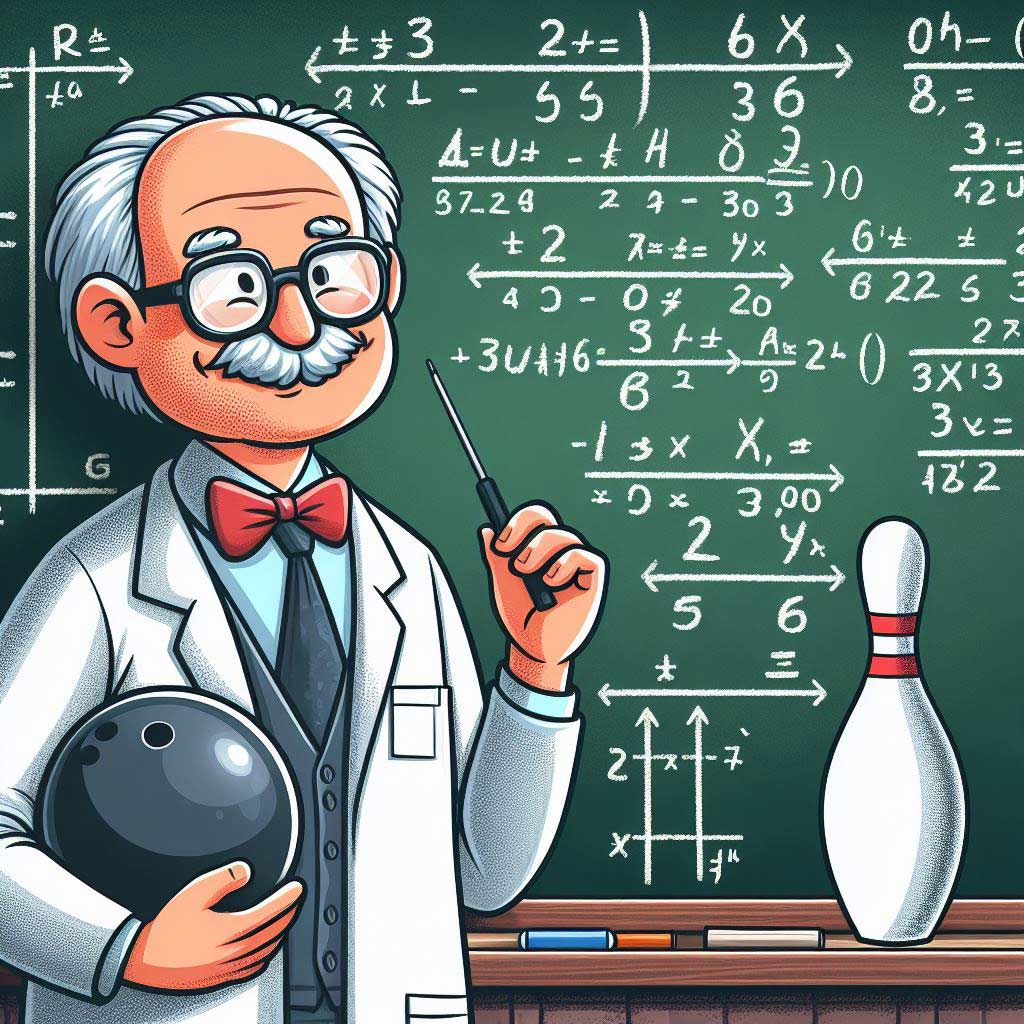Bowling is one of America’s most beloved pastimes, with over 70 million people heading down the lanes every year.
Whether you’re a veteran bowler perfecting complicated hook shots or a beginner still mastering spares, recreational bowling leagues offer fun competition and camaraderie for all skill levels.
That’s where bowling handicaps come in – they help create an even playing field for bowlers of varying abilities.
But how exactly are these handicaps determined? As a bowler, it’s helpful to understand the math behind the magic number that levels the scoreboard for you.
In this guide, we’ll cover everything you need to know about bowling handicap calculations, including:
- What is a bowling handicap
- How handicaps are set
- Averaging bowling scores
- The mathematical formula behind setting handicaps
- Why proper handicapping matters
Let’s get rolling!
What is a Bowling Handicap?
A bowling handicap is a supplemental number of pins awarded to a player per game based on their average bowling score. This handicap number helps narrow the scoring gap between weaker and stronger players.
Essentially, a handicap provides below-average bowlers with “bonus” pins to remain competitive against more skilled opponents who consistently knock down more pins.
After completing a game, the actual (raw) score is combined with the handicap pins to produce a final score. This creates greater balance and equality on the scoresheets.
For example:
- Bowler 1 has a 150 average and a 50-pin handicap
- They bowl 180 in a game
- Their raw score of 180 + 50 handicap pins = final score of 230
Meanwhile, a more advanced bowler might have lower or no handicap, requiring them to bowl very well to achieve a 230 score.
How to Calculate Bowling Handicap?
To calculate an appropriate handicap, the first step is determining a bowler’s current average score. This is based on their most recent 12-15 games bowled within that league. After dropping the outlying highest and lowest scores, the remaining game scores are averaged.
Next, the league’s predetermined standard average is subtracted from the bowler’s average to find their base handicap number. Common standard averages set by leagues are 200 or 220.
The difference between the standard and bowler’s average can then be calculated as a percentage of the standard. Most handicapping systems use either 80% or 90% of the standard average as the benchmark.
For a clear example:
- Bob’s 13 game scores are averaged to 155 after drops
- His league uses 80% of a 220-standard
- 220 standard – 155 average = 65
- 65/220 = 30%
- 30% of 176 (80% of 220 standards) is about 53
So Bob’s handicap would likely be 53 pins per game.
The exact handicapping percentages and approaches can vary quite a bit between different bowling leagues and tournaments. But this gives the basic framework.
Calculating Your Average Bowling Score
Finding your average score requires a sample of at least 12 games to draw data from, but most leagues will want 15-18 games bowled to establish a bowler’s average. You take the total pinfall from those games and divide it by the number of games.
Before dividing though, the highest and lowest outlier scores from your sample should dropped. This prevents one really bad or exceptionally good game from skewing the average too far in either direction.
Many leagues also impose rules about minimum averages or require averages to be re-certified periodically.
For example, bowlers who ended last season with a 165 average may be required to complete a short certification round upon returning in the fall to confirm they are still in that scoring range.
The Math Behind Bowling Handicaps
Now let’s walk through a full example from start to finish to demonstrate the math that transforms your average into handicap bonus pins:
Jen is a rising star in her weekday women’s league, but many veteran teammates still outscore her regularly. Over 15 games this season, she’s averaged a 142 score after dropping outliers.
Her league bases handicaps on 80% of a 220 standard.
- Jen’s average: 142
- League standard: 220
- Subtract average from standard –> 220 – 142 = 78
- Divide difference by standard –> 78/220 = 0.355 = 35.5%
- Multiply that percentage by 80% of standard –> 0.355 * 176 = 63 (rounding down)
Therefore, Jen’s bowling handicap would be 63 pins per game.
For a 160-average bowler in Jen’s league, their calculations would be:
- Average: 160
- Standard: 220
- 220 – 160 = 60
- 60/220 = 0.273 = 27.3%
- 27.3% * 176 = 48 pins
The higher the bowler’s average, the lower the handicap. Meanwhile, newer bowlers will likely receive significant handicap pins in their early seasons. This allows for camaraderie, friendly competition, and watching averages rise across a league.
Why Handicaps Matter in Bowling Leagues
Implementing handicaps may seem overly complex just for recreational bowling. After all, what’s wrong with good bowlers simply scoring higher than beginners?
Plenty, actually. Without handicapping in place, less experienced bowlers may quickly become frustrated and dislike competing head-to-head against far better players. This can diminish their enjoyment of the sport rather than boosting skills through challenge.
Handicapping also encourages veteran league members to share tips and cheer for each other’s success rather than just crushing new additions.
Further, it keeps the standings interesting rather than having one or two bowlers dominate week after week unattainably.
Bowling handicaps help foster an encouraging environment where players of all abilities can thrive and feel part of the in-group. The camaraderie and excitement remain vibrant rather than fizzling out over time.
For many bowlers, their passion for bowling began in casual leagues as a kid just looking to have fun with friends after school.
Maintaining that welcoming spirit and baseline competitiveness is key to drawing more young bowlers into this classic sport.
Key Takeaways on Bowling Handicap Calculations
In summary, here are the key points to retain about recreational bowling league handicap systems:
- Handicaps help level the playing field for bowlers of varying skill levels
- They are calculated based on a percentage of difference between league standard averages and player averages
- Higher averages lead to lower handicaps, and vice versa
- Exact handicapping formulas can vary somewhat between leagues
- Having handicaps enables exciting competition across age and ability levels
While the math may seem imposing, even eight-year-olds can grasp the basic concept of getting “bonus pins” to stay competitive with Mom and Dad.
Understanding handicaps helps bowlers recognize why that extra number gets tacked onto their scores. Newer players can also set goals like improving their average to earn fewer handicap pins down the road.
At the end of the day, bowling is all about smile breaks with family and friends. A fair, understandable handicap system enables recreational leagues to foster lasting bonds across skill levels season after season.
Frequently Asked Questions
How do you figure out your bowling handicap?
To determine your bowling handicap, first calculate your average score over your last 12-15 games bowled in that specific league. After dropping the high and low outliers and averaging the remaining scores, compare your average against the league’s standard handicap baseline, which is commonly 80% of 200 or 220 score. Take the percentage difference and multiply by the standard to get your handicap pins per game.
How does the handicap system work in bowls?
Lawn bowling handicaps work very similarly to tenpin bowling handicaps. Bowlers submit recent scores to determine an average, which sets handicaps based on the differential versus a defined league standard average benchmark. Handicap percentages then determine extra points added per game to help bowlers of different abilities remain competitive on equal terms.
How many games is a bowling handicap?
Most leagues require 12-15 games bowled to establish an accurate average and calculate the associated handicap from that average. After the initial handicap is set, it may remain for a period or need to be re-certified every few months using another sample of 12+ games.
How do you calculate your average score in bowling?
Maintain a log of all your game scores bowled within one league. After having 12+ scores recorded, drop the single highest and lowest outlier games, then sum the remaining game scores and divide by the number of games left. This gives your current average score.
How do you calculate the best ball handicap?
Best ball bowling events involve a team of two or more bowlers combining their single best score from each frame. Calculate handicaps for each bowler separately based on averages. Their respective bonus pins per game then get added only to their own best ball frames that are included in the team total.
Can you have a negative handicap in bowling?
Typically not within recreational league play. Scratch players or professionals might have a negative handicap designation in certain tournament formats, but amateur league bowlers with averages above the standard would simply have a “0” handicap.
How many scores do you need for a handicap?
Most leagues require a minimum of 12 complete game scores rolled within that specific league to establish an accurate average and calculate the associated handicap number. More scores provide better data, so 15+ scores are ideal if possible.
Is there a handicap system in bowls?
Yes, lawn bowling leagues and competitions can use a handicap system to enable fair play between bowlers and teams of different abilities. Handicaps are determined via averages like in tenpin bowling and applied by adding or subtracting set points per game based on skill differential.





